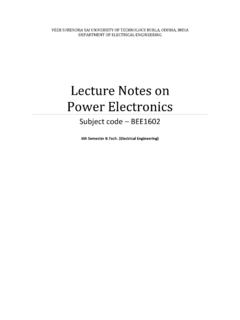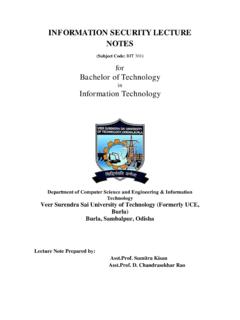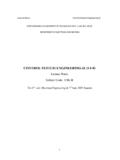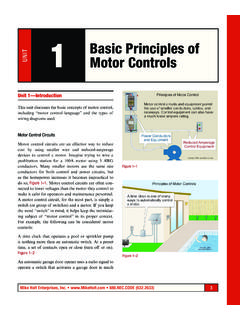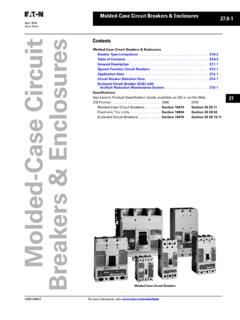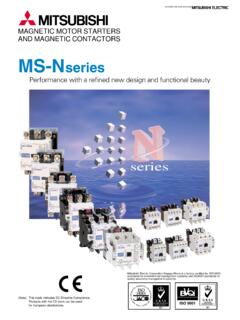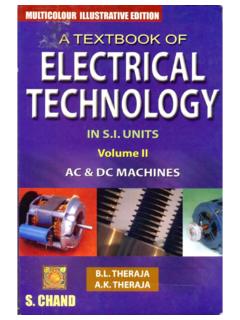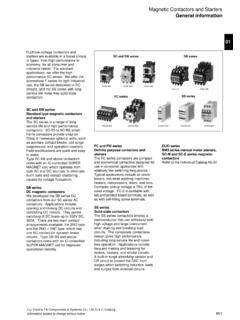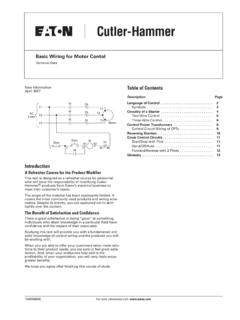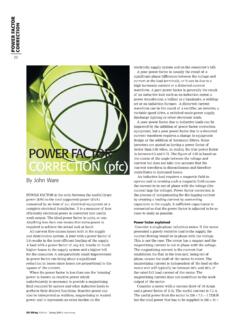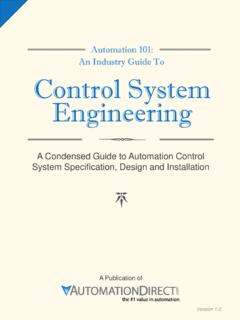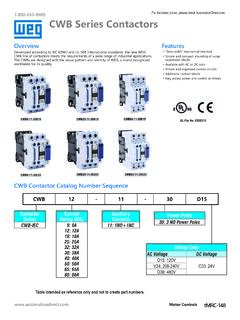Transcription of ELECTRICAL MACHINE-II
1 LECTURE NOTES ON ELECTRICAL MACHINE-II Subject Code - BEE 1401 For B-Tech 4th SEM EE & EEE [Part-II] [Module-III & IV] VEER SURENDRA SAI UNIVERSITY OF TECHNOLOGY Department of ELECTRICAL Engineering Burla, Sambalpur, Odisha 768018 Lecture Notes ELECTRICAL machine - II [BEE 1401] Page | 1 Syllabus of Bachelor of Technology in ELECTRICAL Engineering (4th SEMESTER) ELECTRICAL MACHINES-II Subject Code: BEE 1401 Topics Page No. MODULE-III Three Phase Induction Motors: Types, Construction and principle of operation, 3 phase Induction motor , general phasor diagram, equivalent circuit, power and torque relations, condition for maximum torque, circle diagram, Performance characteristics, effect of rotor resistance on speed torque characteristics, stable & unstable region of operation, Operation with unbalanced supply voltage.
2 Starting: Starting of 3 phase induction motors, high starting torque motors, speed control, rheostatic method, pole changing method, cascade control of speed, Double cage induction motor , Cogging and Crawling of Induction motor , Induction generator. 3-67 MODULE-IV Single phase induction motor , theory of operation (Double revolving field theory, equivalent circuit, Determination of parameters) Methods of starting, split phase starting, Repulsion starting, shaded pole starting, performance characteristics. Single phase series motor , theory of operation performance and application, Shcrage motor , Universal motor . 68-99 EE DEPT.
3 Veer Surendra Sai University of Technology, Burla Lecture Notes ELECTRICAL machine - II [BEE 1401] Page | 2 Disclaimer This document does not claim any originality and cannot be used as a substitute for prescribed textbooks. The information presented here is merely a collection by the committee members for their respective teaching assignments. Various sources as mentioned at the end of the document as well as freely available material from internet were consulted for preparing this document. The ownership of the information lies with the respective authors or institutions. Further, this document is not intended to be used for commercial purpose and the committee members are not accountable for any issues, legal or otherwise, arising out of use of this document.
4 The committee members make no representations or warranties with respect to the accuracy or completeness of the contents of this document and specifically disclaim any implied warranties of merchantability or fitness for a particular purpose. The committee members shall not be liable for any loss of profit or any other commercial damages, including but not limited to special, incidental, consequential, or other damages. EE DEPT. Veer Surendra Sai University of Technology, Burla MODULE-III THREE PHASE INDCTION motor SYLLABUS/ TOPICS COVERED Three Phase Induction Motors: Types, Construction and principle of operation, 3 phase Induction motor , general phasor diagram, equivalent circuit, power and torque relations, condition for maximum torque, circle diagram, Performance characteristics, effect of rotor resistance on speed torque characteristics, stable & unstable region of operation, Operation with unbalanced supply voltage.
5 Starting: Starting of 3 phase induction motors, high starting torque motors, speed control, rheostatic method, pole changing method cascade control of speed, Double cage induction motor , Cogging and Crawling of Induction motor , induction generator [Topics are arranged as per above sequence] Lecture Notes ELECTRICAL machine - II [BEE 1401] Page | 4 Module-III Three Phase Induction motor The most common type of AC motor being used throughout the work today is the "Induction motor ". Applications of three-phase induction motors of size varying from half a kilowatt to thousands of kilowatts are numerous. They are found everywhere from a small workshop to a large manufacturing industry.
6 The advantages of three-phase AC induction motor are listed below: Simple design Rugged construction Reliable operation Low initial cost Easy operation and simple maintenance Simple control gear for starting and speed control High efficiency. Induction motor is originated in the year 1891 with crude construction (The induction machine principle was invented by NIKOLA TESLA in 1888.). Then an improved construction with distributed stator windings and a cage rotor was built. The slip ring rotor was developed after a decade or so. Since then a lot of improvement has taken place on the design of these two types of induction motors. Lot of research work has been carried out to improve its power factor and to achieve suitable methods of speed control.
7 Types and Construction of Three Phase Induction motor Three phase induction motors are constructed into two major types: 1. Squirrel cage Induction Motors 2. Slip ring Induction Motors Squirrel cage Induction Motors (a) Stator Construction The induction motor stator resembles the stator of a revolving field, three phase alternator. The stator or the stationary part consists of three phase winding held in place in the slots of a laminated steel core which is enclosed and supported by a cast iron or a steel frame as shown in Fig: (a). EE DEPT. Veer Surendra Sai University of Technology, Burla Lecture Notes ELECTRICAL machine - II [BEE 1401] Page | 5 The phase windings are placed 120 ELECTRICAL degrees apart and may be connected in either star or delta externally, for which six leads are brought out to a terminal box mounted on the frame of the motor .
8 When the stator is energized from a three phase voltage it will produce a rotating magnetic field in the stator core. Fig: (b) Rotor Construction The rotor of the squirrel cage motor shown in Fig: (b) contains no windings. Instead it is a cylindrical core constructed of steel laminations with conductor bars mounted parallel to the shaft and embedded near the surface of the rotor core. These conductor bars are short circuited by an end rings at both end of the rotor core. In large machines, these conductor bars and the end rings are made up of copper with the bars brazed or welded to the end rings shown in Fig: (b).In small machines the conductor bars and end rings are sometimes made of aluminium with the bars and rings cast in as part of the rotor core.
9 Actually the entire construction (bars and end-rings) resembles a squirrel cage, from which the name is derived. The rotor or rotating part is not connected electrically to the power supply but has voltage induced in it by transformer action from the stator. For this reason, the stator is sometimes called the primary and the rotor is referred to as the secondary of the motor since the motor operates on the principle of induction and as the construction of the rotor with the bars and end rings resembles a squirrel cage, the squirrel cage induction motor is used. The rotor bars are not insulated from the rotor core because they are made of metals having less resistance than the core. The induced current will flow mainly in them.
10 Also the rotor bars are usually not quite parallel to the rotor shaft but are mounted in a slightly skewed position. This feature tends to produce a more uniform rotor field and torque. Also it helps to reduce some of the internal magnetic noise when the motor is running. EE DEPT. Veer Surendra Sai University of Technology, Burla Lecture Notes ELECTRICAL machine - II [BEE 1401] Page | 6 (c) End Shields The function of the two end shields is to support the rotor shaft. They are fitted with bearings and attached to the stator frame with the help of studs or bolts attention. Slip ring Induction Motors (a) Stator Construction The construction of the slip ring induction motor is exactly similar to the construction of squirrel cage induction motor .



